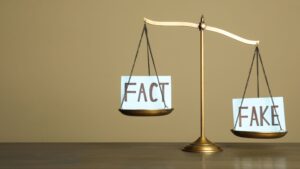Greenwashing has been a hot topic on the green agenda lately. Whilst it’s rife in all businesses, the fashion industry is one of the biggest culprits of greenwashing. We’re seeing increasingly bigger players in the fashion world jumping on the green bandwagon, yet many people don’t even know what ‘greenwashing’ means. In today’s blog, I’ll help you understand the concept of greenwashing, share key facts, and call out some of the high street’s biggest offenders.
I have adapted this blog based on one I wrote back in 2018 for Ethical Brand Directory: What is Greenwashing
What does Greenwashing look like?
In a nutshell – greenwashing is misdirection. This is done by using misleading information, and vague and unsubstantiated claims to appear eco-friendly and gloss over the bad stuff. The goal is to get people to focus on the good stuff (usually a small piece of the overall picture) like a percentage of recycled materials used in a new line of a fashion brand’s latest collection. This makes a company appear more environmentally friendly than it is – which enables a company to financially benefit from people who wish to support greener products and initiatives.
Greenwashing is the eco-version of white lies – it’s an attempt to appear more green, sustainable and ethical and distract people from the everyday reality of what’s not being done.
It’s by no means a new expression or concept – it was officially coined by environmentalist Jay Westerveld in 1986! – but in the wake of the climate crisis and the rise of conscious consumerism, it pays for companies to be green. According to a report by Nielsen, 66% of global consumers say they’re willing to pay more for sustainable brands. It’s great to see consumers investing in sustainable brands – however, this has also led companies to portray a ‘green’ image for the sake of sales.
A shocking 98% of green-labelled products are thought to be greenwashed! Greenwashing is a widespread and rather sinister tactic used to distract consumers from the unethical work going on behind the scenes.
Who is greenwashing?
Sadly, lots of people are doing this. More businesses do this than we realise. Now that people are more interested in environmentally conscious products and services – businesses are using their minimal green credentials for marketing gain.
“People are getting more aware of the rarity of the Earth and the ways that our actions impact it,” says Jason Ballard, CEO of sustainable home improvement retailer TreeHouse. At the same time, he notes, greenwashing has become more complex. “It’s the dark side of very positive development. It’s misdirection, and it’s intended to shift the customer’s focus from a company’s appalling behaviours to something that’s peripheral,” (Source: Guardian)
As it stands, the act of greenwashing is not an illegal practice, because unfortunately there is not a legal standard. So it lies with us, the consumers, to call out the companies we see making misleading or straight-up false claims about their ‘green’ actions.
It is not enough for companies to release a ‘sustainable’ collection and claim to be a conscious brand. We need to see full transparency about their business operations, sourcing, fair labour, environmental policy etc.
Greenwashing: Does Primark Care?
Recently, fast-fashion retailer, Primark, started their nationwide campaign: #PrimarkCares. This is greenwashing or ‘purpose washing’ at its finest. How can a business based on a fast-fashion model that exploits cheap labour claim to care? It’s like BooHoo’s claims of being sustainable. Laughable. The model these businesses are built on pushing cheap labour and fastly producing clothing at the expense of workers and the planet. My pal Olivia Pinnock talks about this in her article on Forbes: How Sustainable is Primark’s Sustainable Cotton Programme?
The bottom line is producing a high volume of product (even if it’s cheaper and made with sustainable cotton) just isn’t sustainable when you put the welfare of the planet first.
Once upon a time I used to shop at Primark for cheap socks and throwaway clothes for festivals and my holidays. I didn’t know the things I know now about the fashion industry and how clothes were produced back then.
It’s worth acknowledging when a big brand like H&M or Primark tries to do ‘better’ it’s not a bad thing unless it’s done in a way that distracts us from the things that should be done. I honestly do appreciate when a brand starts making changes. However, I cannot praise Primark for initiating a campaign about caring until I see much more ‘change’ and evidence that includes the entire business model. One line of clothing is not enough to say “Primak Cares” the entire business must operate ethically, and this means every garment will cost more and every garment professional will be paid more (a living wage).
Greenwashing: Is H&M really sustainable?
H&M is another well-known high-street brand accused of greenwashing. Last year (2020) the retailer released its ‘sustainable’ Conscious Collection, yet according to The Norwegian Consumer Authority, H&M provides “insufficient” information about the nature of its “sustainable collection”. Beyond releasing questionable collections, H&M can often be spotted pushing their ‘green’ message in campaigns, which often feature heavy greenery and natural imagery.
The Billie Eillesh collection widely touted as a ‘sustainable drop’ at H&M has also been criticised by sustainable fashionistas too. H&M says it’s “sourced in a more sustainable way” according to a press release. What does ‘more sustainable way’ mean? It’s unclear and that’s the problem.
You’ll notice that H&M uses green colours, a minimalist backdrop and plants, a widely used aesthetic for “sustainable products’. The subliminal message is that its natural, green eco-friendly, and kind to nature… but without a big sign explaining what percentage that is – it’s far too misleading.
I hope you’ve enjoyed reading this blog and feel more informed on the issue of greenwashing. Have you spotted examples of big brands greenwashing?
I’d love to hear your thoughts and experiences on the topic in the comments below
Roberta x

FOR STYLE THAT EMPOWERS & CONFIDENCE THAT INSPIRES.
Doing ‘fashion’ the sustainable way

Everything you need to know to create a style you love – and a wardrobe full of clothes you’re excited to wear.



